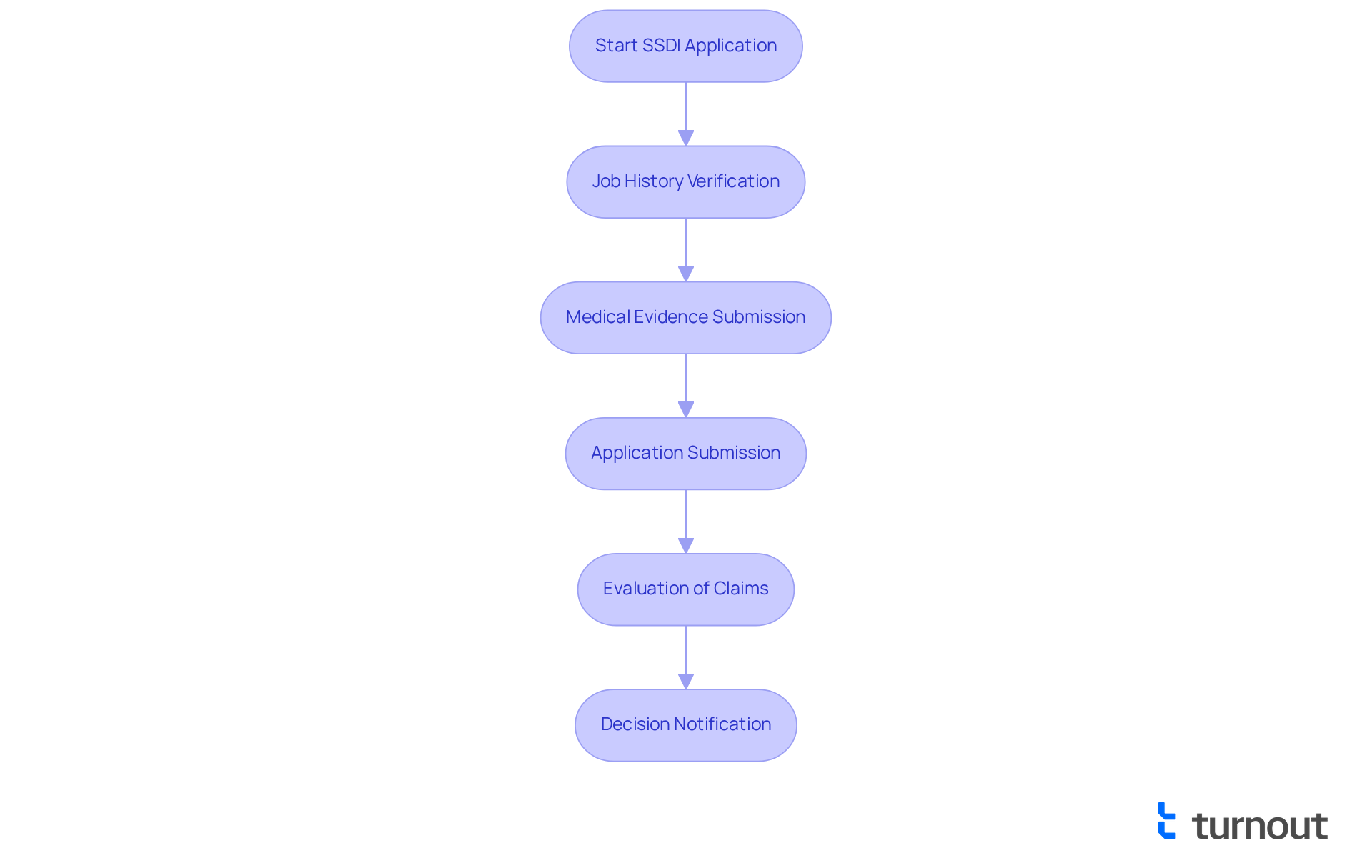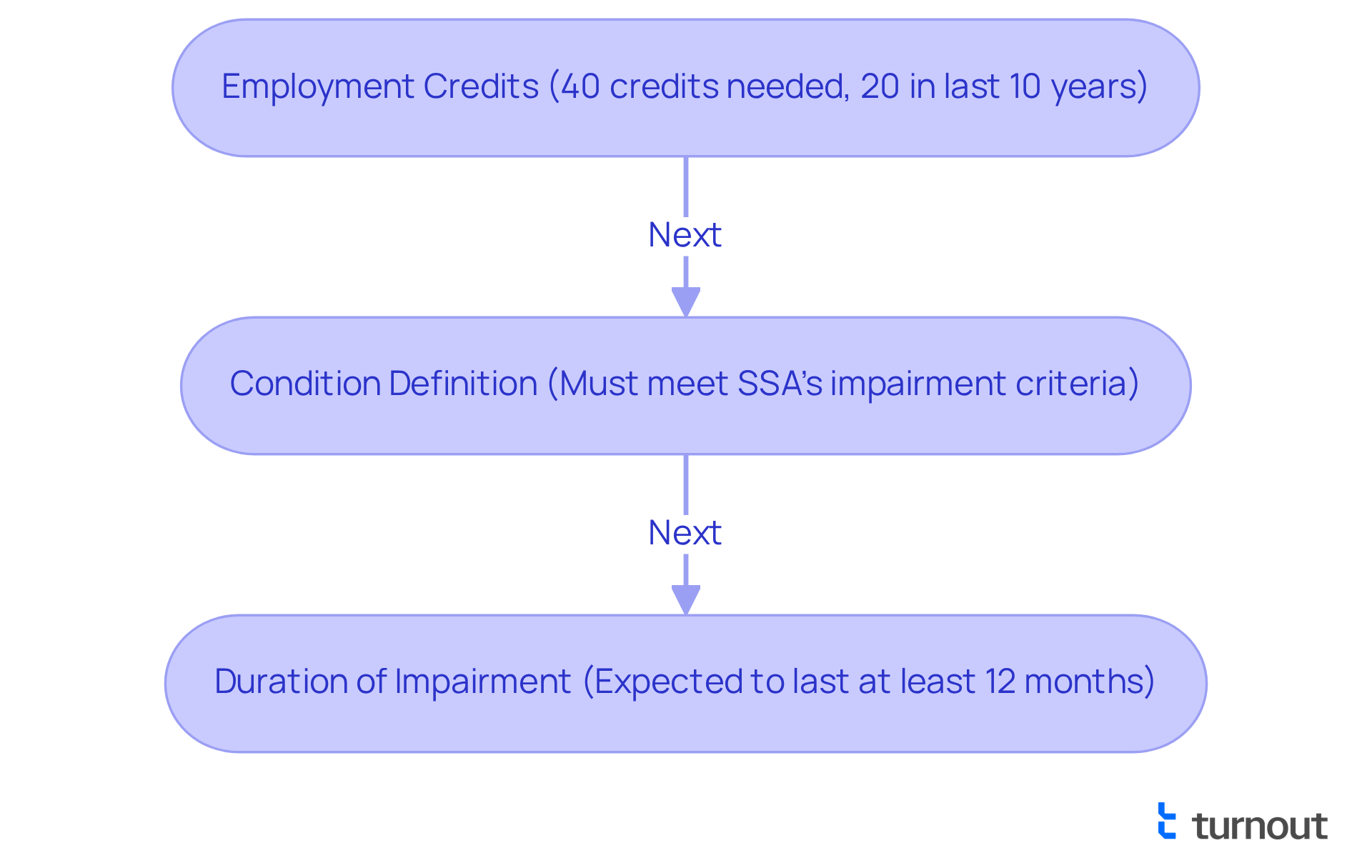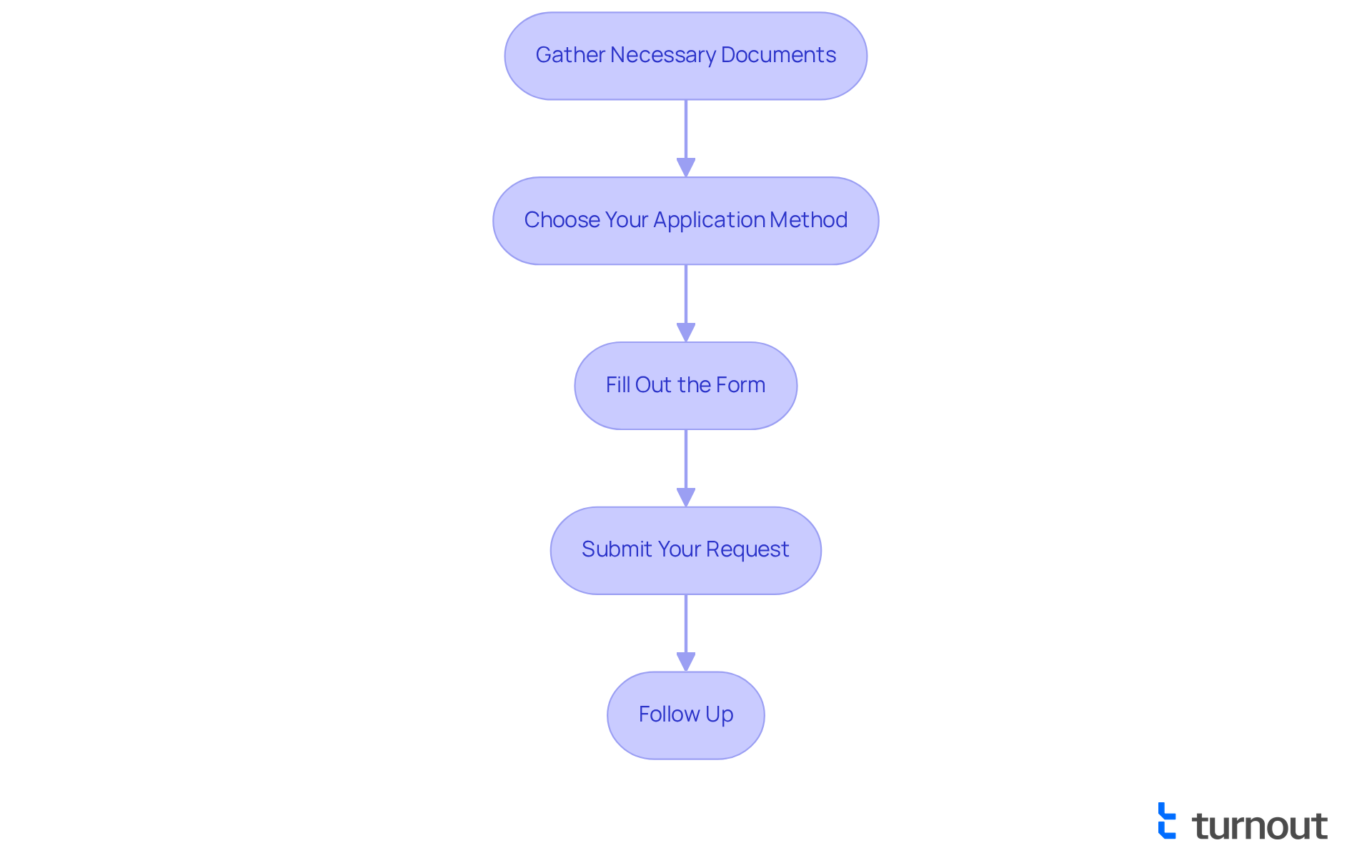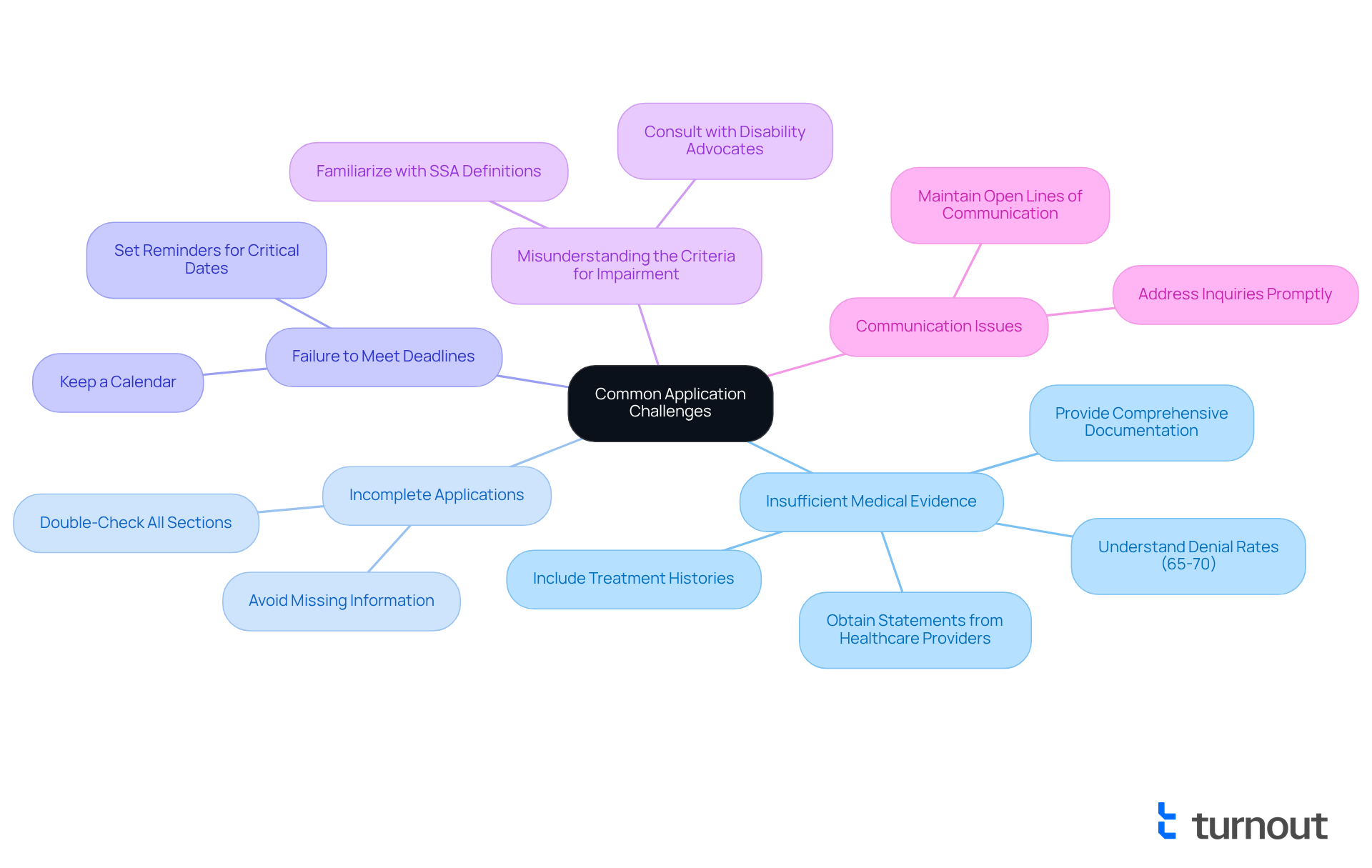Overview
Navigating the Social Security Disability Insurance (SSDI) application process can feel overwhelming. We understand that many individuals face challenges and uncertainties during this journey. This article offers a supportive guide to help you effectively manage the application process.
- First, it’s essential to determine your eligibility. Knowing where you stand can alleviate some of the stress.
- Next, gathering the necessary documentation is crucial. This step can seem daunting, but with thorough preparation, you can feel more confident in your approach.
- Additionally, understanding common challenges is vital. Many applicants encounter obstacles, and it’s completely normal to feel concerned.
- Seeking professional assistance can significantly enhance your chances of approval. Remember, you are not alone in this journey.
By taking these steps and preparing adequately, you can navigate the SSDI application process with greater ease. We’re here to help you every step of the way.
Introduction
Navigating the intricacies of the Social Security Disability Insurance (SSDI) application process can feel like an uphill battle for many individuals facing disabilities. We understand that with over 5 million Americans relying on this essential program for financial support, it’s crucial to grasp the eligibility criteria and application steps. This knowledge can significantly enhance your quality of life. However, it's common to feel overwhelmed by the challenges that lie ahead.
So, what are the most effective strategies to master this complex process and avoid common pitfalls? We're here to help you through this journey.
Understand Social Security Disability Insurance (SSDI)
Disability social security, particularly through the Social Security Disability Insurance program, is a vital national program that provides financial assistance to individuals who are unable to work due to qualifying conditions. We understand that navigating this process can be overwhelming, but it's important to know that help is available. To qualify for SSDI, applicants must have a job history that includes paying Social Security taxes and must demonstrate that their impairment significantly impacts their ability to engage in substantial gainful activity. This program supports over 5 million Americans seeking disability social security due to illness or injury, underscoring its critical role in offering necessary support.
Key aspects of SSDI include:
- It is specifically designed for individuals who have contributed to the Social Security system through their work.
- Benefits are available to those whose disabilities are expected to last at least one year or result in death.
- The program is funded through payroll taxes collected from both workers and their employers.
Looking ahead to 2025, the impact of disability social security, specifically through Social Security Disability Insurance, on disabled individuals will be significant, especially with the anticipated 2.5% increase in monthly benefits due to the cost-of-living adjustment (COLA). This adjustment is crucial as it helps recipients manage rising living expenses driven by inflation.
Statistics reveal that approximately 30% of disability applicants qualify for benefits. It's common to feel uncertain about eligibility, but understanding the requirements and application process is essential. Engaging with knowledgeable advocates can greatly enhance your chances of approval, ensuring that you receive the support you deserve. The disability claims process follows a five-step sequential evaluation method defined by U.S. law, which plays a key role in determining eligibility.
Real-world examples illustrate the importance of understanding disability social security benefits. Many applicants have successfully navigated the system with the right guidance, leading to positive outcomes. For instance, clients of advocacy groups have shared feelings of empowerment and support throughout their claims process, highlighting the value of professional assistance in overcoming bureaucratic challenges. As advocates for individuals with impairments often say, "Navigating the Social Security Disability Insurance process can be overwhelming, but with the appropriate support, you can obtain the benefits you need to enhance your quality of life." Remember, you are not alone in this journey; we’re here to help.

Determine Your Eligibility for SSDI Benefits
Determining your eligibility for disability social security benefits, such as Social Security Disability Insurance (SSDI), can feel overwhelming. We understand that navigating this process is challenging, and we’re here to help. Consider these important criteria:
-
Employment Credits: Typically, you need to have accumulated 40 employment credits, with at least 20 of those earned in the last 10 years before your disability onset. In 2025, you can earn a maximum of four credits per year, requiring at least $7,240 in earnings. If you’re younger, you may qualify with fewer credits based on your age and work history. Remember, one labor credit is earned for every $1,690 in wages or self-employment income in 2025.
-
Condition Definition: Your situation must align with the Social Security Administration's (SSA) criteria for impairment. This means your condition should significantly limit your ability to perform basic work activities. It can include severe physical disorders, mental health conditions, or neurological diseases.
-
Duration of Impairment: The SSA requires that your condition is expected to last at least 12 months or result in death.
To effectively assess your eligibility, we encourage you to use the SSA's online tools or consult with a knowledgeable disability benefits advocate. It’s essential to have a legal team to help you navigate potential changes in disability social security benefits, particularly those related to the Social Security Fairness Act, which impacts over 3.2 million people. Understanding the recent changes to disability social security eligibility criteria, including adjustments in credit thresholds and the Substantial Gainful Activity (SGA) limits, is crucial for a successful application. For example, in 2025, the monthly SGA amount is set at $1,620 for non-blind individuals and $2,700 for statutorily blind individuals. This can impact your eligibility if you are working part-time while applying for benefits.
Remember, you are not alone in this journey. We’re here to support you every step of the way.

Complete the SSDI Application Process
Completing the disability social security application process can feel overwhelming, but we're here to help. There are several key steps to follow that can make this journey smoother:
-
Gather Necessary Documents: Start by collecting essential personal information, such as your Social Security number, birth certificate, and medical records. Additionally, compile details about your work history for the past 15 years and any treatments you have received. It's important to note that approximately 65-70% of initial disability social security benefit requests are denied, often due to incomplete information or insufficient medical evidence. This makes thorough documentation crucial.
-
Choose Your Application Method: You have options when it comes to applying. You can apply online through the SSA website, by phone, or in person at your local Social Security office. Online submissions are typically quicker and more effective, enabling faster processing compared to traditional methods. Remember, the SSA requires permission to access medical records and a verified earnings record when applying online.
-
Fill Out the Form: When completing the SSDI request form (SSA-16), be thorough and honest in your responses. Providing detailed information about your medical condition and its impact on your daily life is essential. Sharing specific instances of how your condition affects your ability to work can greatly enhance your submission. Maintaining detailed records of how your disability interferes with daily life is vital.
-
Submit Your Request: Once you've reviewed your submission for accuracy, send it through your chosen method. If applying online, ensure you follow all prompts and submit any required documents. It's important to keep in mind that there is a mandatory five-month waiting period after SSDI approval before benefits begin, so timely submission is essential. The review process typically takes three to five months, but it can extend longer if an appeal is necessary.
-
Follow Up: After submission, monitor your status through the SSA website or by reaching out to their office. Be prepared to provide additional information if requested. If your request is denied, remember that you have the right to contest the decision.
By adhering to these steps and ensuring that all paperwork is thorough, you can enhance your likelihood of a successful request for disability social security benefits. You're not alone in this journey, and taking these steps can lead you closer to the support you need.

Troubleshoot Common Application Challenges
Navigating the disability social security application process can feel overwhelming. Many applicants face common challenges that can make this journey even more daunting:
-
Insufficient Medical Evidence: Providing comprehensive medical documentation is crucial. This should include detailed treatment histories, test results, and statements from healthcare providers that clearly outline your condition and its impact on your ability to work. It's important to know that around 65-70% of initial disability social security claims are rejected, often due to inadequate medical evidence. As T.J. Geist, a principal advocate at Allsup, wisely points out, "The SSDI submission process can feel overwhelming, especially with the added delays at the SSA." By starting with expert assistance, you can avoid common pitfalls, strengthen your case, and improve your chances of approval on the first try.
-
Incomplete Applications: We understand that completing every section of your application can be challenging. Missing information may lead to unnecessary delays or outright denials, so it’s essential to double-check your submission.
-
Failure to Meet Deadlines: It's common to feel overwhelmed by deadlines for submitting documents or responding to requests from the Social Security Administration (SSA). Keeping a calendar or setting reminders can help you stay organized and avoid missing critical dates.
-
Misunderstanding the Criteria for Impairment: Familiarizing yourself with the SSA's definition of impairment is vital to ensure your condition qualifies. If you are uncertain, consulting with a disability advocate can provide clarity and guidance.
-
Communication Issues: Maintaining open lines of communication with the SSA is essential. Quickly addressing inquiries for further details can help you avoid hold-ups in your process.
By understanding these challenges and taking proactive steps, you can significantly improve your chances of a successful disability social security application. Remember, you are not alone in this journey. Many applicants face similar hurdles, underscoring the importance of being well-prepared and informed. We're here to help you navigate this process with confidence.

Conclusion
Mastering the Social Security Disability Insurance (SSDI) application process is essential for individuals seeking the financial support they need during challenging times. We understand that the complexity of this journey can be daunting, but knowing the program and its requirements is the first step toward securing the benefits that can enhance your quality of life. By familiarizing yourself with the eligibility criteria and necessary documentation, you can approach the process with confidence and clarity.
Key insights from this guide highlight the importance of:
- Gathering comprehensive medical evidence
- Accurately completing application forms
- Understanding the criteria set forth by the Social Security Administration
Engaging with knowledgeable advocates can significantly improve your chances of approval. It's common to feel overwhelmed, especially since a substantial percentage of initial applications are denied due to insufficient information or documentation. The five-step evaluation process for determining eligibility serves as a crucial framework for you to follow, ensuring that you meet all necessary criteria.
Ultimately, navigating the SSDI application process is not just about securing financial assistance; it is about reclaiming your independence and stability in the face of adversity. By taking proactive steps, staying organized, and seeking support when needed, you can successfully overcome common challenges and move closer to obtaining the benefits you deserve. Embracing this journey with the right resources and guidance transforms the application process from a source of stress into a path toward empowerment and hope. Remember, you are not alone in this journey; we’re here to help you every step of the way.
Frequently Asked Questions
What is Social Security Disability Insurance (SSDI)?
SSDI is a national program that provides financial assistance to individuals who are unable to work due to qualifying conditions, supporting over 5 million Americans due to illness or injury.
Who qualifies for SSDI?
To qualify for SSDI, applicants must have a job history that includes paying Social Security taxes and must demonstrate that their impairment significantly impacts their ability to engage in substantial gainful activity. Disabilities must be expected to last at least one year or result in death.
How is SSDI funded?
The SSDI program is funded through payroll taxes collected from both workers and their employers.
What is the significance of the cost-of-living adjustment (COLA) for SSDI recipients?
The anticipated 2.5% increase in monthly benefits due to COLA in 2025 is crucial for helping recipients manage rising living expenses driven by inflation.
What percentage of disability applicants typically qualify for SSDI benefits?
Approximately 30% of disability applicants qualify for benefits.
What is the disability claims process for SSDI?
The disability claims process follows a five-step sequential evaluation method defined by U.S. law, which determines eligibility for benefits.
How can advocates assist with the SSDI application process?
Engaging with knowledgeable advocates can enhance your chances of approval and provide support throughout the claims process, making it easier to navigate bureaucratic challenges.
What are the benefits of understanding SSDI?
Understanding the requirements and application process is essential for applicants, as many have successfully navigated the system with the right guidance, leading to positive outcomes and improved quality of life.




